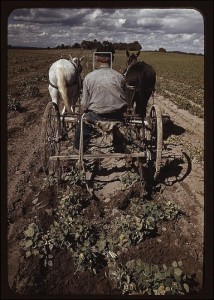But First, What Are Legumes or Pulses?
To start, I had to look up the difference between a legume and a pulse… pulses are the edible seeds that grow on a legume. Legumes are shrubs, herbs, and trees that produce pod-shaped fruit. The pods are what hold the pulses (such as peas). For the rest of the post, I’ll just say ‘beans’, though most of what I refer to in this post applies to other pulses as well, such as chickpeas, mung beans, lentils, peas, peanuts, etc.
Purchasing and Using Beans
Beans are also a food that helps us to be a little frugal. Beans are not expensive, yet, they are very filling, nutritious and easy to incorporate into all kinds of recipes (soups, chili, tacos, salads, hummus, wraps, casseroles and even sauces). Organic beans can be bought in bulk (such as Palouse brand at Pantry Paratus or Frontier brand at Amazon) – they don’t go bad within a week or two like some vegetables and are easy to store while dry or after being cooked.
 It is easy to create large batches of and put into the freezer for using at a later time. It’s super simple to soak the beans to either sprout them or cook them, and it really doesn’t take much of our actual time. It just takes a day ahead of planning so they can sit a night or two on the counter.
It is easy to create large batches of and put into the freezer for using at a later time. It’s super simple to soak the beans to either sprout them or cook them, and it really doesn’t take much of our actual time. It just takes a day ahead of planning so they can sit a night or two on the counter.
Just as I mentioned with nuts, know your source. It’s best to use fresh, organic or naturally grown beans (non-GMO, no preservative sprays, not irradiated and no pesticides) that have been grown in nutrient rich soil. We want the nutrients, but not the pesticides. It’s best to have beans from the last harvest. You don’t want old or mis-handled beans. When they are old (1 1/2+ years), the chances are higher that they’ve been improperly stored at high temperatures or high humidity and sometimes they just won’t soften even when cooked. Ways you can avoid this is to check the package date, and buy from a place that has a good turnover rate. Some things to consider that may affect the quality of the bean are whether they were stored in a dry, dark and cool place.
Benefits when Soaking Legumes or Pulses
Soaking beans is a traditional food preparation method that has been around for centuries. There are major benefits to soaking beans.
One is to soften them up and lower the cooking time required. Rehydrating the beans ahead of time, allows cooking time to be shortened by as much as an hour. This also saves in gas or electricity.
 Second, as I mentioned in my ‘Are Nuts Really Healthy?’ post, we want to soak them to release the healthy nutrients for us to consume. Beans are packed full of proteins, vitamins (especially B), minerals and amino acids. Beans also contain complex sugars. We want to rid the beans first of their natural enzyme inhibitors. Enzyme inhibitors do not allow us to digest our food well. Soaking releases phytase which neutralizes phytic acid. When phytic acid is not neutralized, it binds to minerals like magnesium, calcium and zinc, which means that it will pull out some good nutrients from our body – which is why it is called an ‘anti-nutrient’. Soaking also allows the breakdown of starches. Basically, soaking releases nutrients for us to more readily absorb and neutralize anti-nutrients. By skipping the soaking process, such as in refined and processed food, they are not as nutrient dense and it can be more difficult to digest. Going one step further, soaking longer, to the point of sprouting, makes them even more digestible by decreasing the carb content and starch and increasing the fiber.
Second, as I mentioned in my ‘Are Nuts Really Healthy?’ post, we want to soak them to release the healthy nutrients for us to consume. Beans are packed full of proteins, vitamins (especially B), minerals and amino acids. Beans also contain complex sugars. We want to rid the beans first of their natural enzyme inhibitors. Enzyme inhibitors do not allow us to digest our food well. Soaking releases phytase which neutralizes phytic acid. When phytic acid is not neutralized, it binds to minerals like magnesium, calcium and zinc, which means that it will pull out some good nutrients from our body – which is why it is called an ‘anti-nutrient’. Soaking also allows the breakdown of starches. Basically, soaking releases nutrients for us to more readily absorb and neutralize anti-nutrients. By skipping the soaking process, such as in refined and processed food, they are not as nutrient dense and it can be more difficult to digest. Going one step further, soaking longer, to the point of sprouting, makes them even more digestible by decreasing the carb content and starch and increasing the fiber.
 There are a couple of exceptions worth mentioning. Soybeans are higher than most in phytic acid and contain strong enzyme inhibitors which are not easily deactivated by soaking and cooking. Soy beans are best fermented such as miso, tempeh and natto (one amongst several reasons I don’t drink soy milk). Being part Asian, I grew up with natto (and I still don’t like it – though the rest of my family LOVE it). It’s a taste that is quite different… just buy a tiny package to try it out… but it’s great for you if you enjoy the taste. The other exception is Fava beans. Soaking, sprouting or fermenting doesn’t help neutralize a certain substance that is in the Fava bean and can cause hemolytic anemia. It is an inherited condition and can be life threatening, as a dear friend knows all too well. Not a high percentage of people have this, but something to be aware of.
There are a couple of exceptions worth mentioning. Soybeans are higher than most in phytic acid and contain strong enzyme inhibitors which are not easily deactivated by soaking and cooking. Soy beans are best fermented such as miso, tempeh and natto (one amongst several reasons I don’t drink soy milk). Being part Asian, I grew up with natto (and I still don’t like it – though the rest of my family LOVE it). It’s a taste that is quite different… just buy a tiny package to try it out… but it’s great for you if you enjoy the taste. The other exception is Fava beans. Soaking, sprouting or fermenting doesn’t help neutralize a certain substance that is in the Fava bean and can cause hemolytic anemia. It is an inherited condition and can be life threatening, as a dear friend knows all too well. Not a high percentage of people have this, but something to be aware of.
And, as I’ve read and personally experienced – the texture and taste is so much better when soaked!

Recipes
Here is a recipe that is quick to make using beans: Mediterranean Garbanzo and Black Bean Salad
And here is a recipe with information on: Time for Beans to Soak, Sprout and Cook (will be posted in a few days).
COMMENTS Your thoughts? Do you soak your beans? COMMENT section is at the bottom of the page.
SUBSCRIBE to get FREE Blog Updates – get future posts on subjects that may interest you by clicking Subscribe
SHARE THIS ARTICLE or this site with your friends by using the social media icons directly below or on the right side of the page.
sources:
westonaprice.org,
photo credits:
Spilling the Beans by Roger Smith on flickr,
Bill Stagg turning up pinto beans, Pie Town, New Mexico by LOC on flickr,
chick peas by damian_m on flickr,
Pinto beans, main crop at Pie Town, New Mexico by LOC on flickr,
disclosure: cmp.ly/4 and cmp.ly/5
Disclosure: Please know that if you make a purchase using a link on this post or site, I may earn a small commission. Some of the links are affiliate links, and when you click them you allow me to cover a small portion of the cost of this blog. I am very grateful for your support of this site - Thank You! You can read all the fine print here







Having read this I believed it was extremely informative.
I appreciate you taking the time and effort to put this short article together.
I once again find myself personally spending way too much time both reading and commenting.
But so what, it was still worth it!